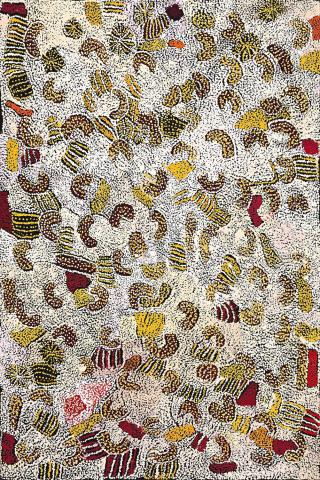PARWALLA, 2005
ELIZABETH NYUMI NUNGURRAYI
synthetic polymer paint on linen
180.0 x 120.0 cm
bears inscription verso: artist's name, size and Warlayirti artists cat. 127/05
Warlayirti Artists, Balgo Hills
Aboriginal and Pacific Art, Sydney
Private collection, Sydney
This work is accompanied by a certificate of authenticity from Warlayirti Artists, Balgo Hills.
Invited to participate in On Reason and Emotion, the 2004 Biennale of Sydney, Elizabeth Nyumi presented canvases that reflected her strong personal style. As with our work the paintings in the Biennale had thick impasto dotting that built up fields of texture, heavily laden with white or cream where motifs of coolomons, boomwerangs, digging sticks and bush tucker standout. In the catalogue which accompanied the Biennale, Hetti Perkins described Nyumi's paintings as expressing 'more than a nostalgic yearning for the past. The arrangement of formal elements in her works articulates the physical connection of desert dwellers to their country. The act of painting Tjukurrpa as an expression of knowledge and creativity reveals a blueprint for physical survival and at the same time regenerates the transcendent energy of the Tjukurrpa. Thus, Nyumi's paintings afford an unequivocal understanding of the symbiotic relationship of Aboriginal people and country.’1
The accompanying certificate of authenticity states in part: ’This painting depicts the country known as Parwalla, which is Nyumi's father’s country. This country is far to the south of Balgo in the Great Sandy Desert, west of Kiwirrkurra, and is dominated by Tali (sandhills). Parwalla is a large swampy area, which fills with water after the wet season rain and consequently produces an abundance of bush foods. The majority of Nyumi’s painting shows different foods… the whitish colours, which dominate the painting, represent the spinifex that grows strong.'
1. Perkins, H., 'Elizabeth Nyumi Nungurrayi', in Carlos, I., (ed.), Biennale of Sydney 2004: On Reason and Emotion, Biennale of Sydney, Sydney, 2004, p. 162
